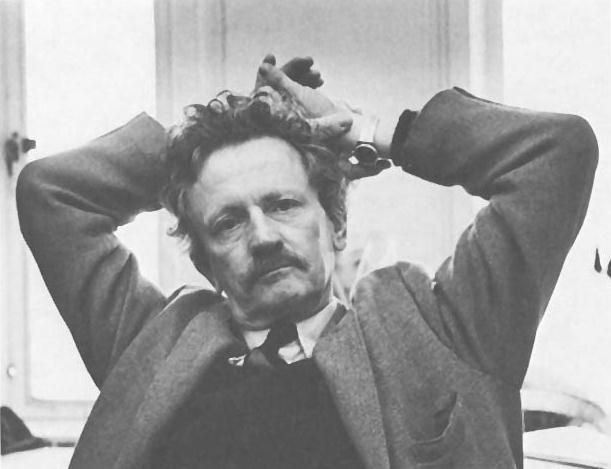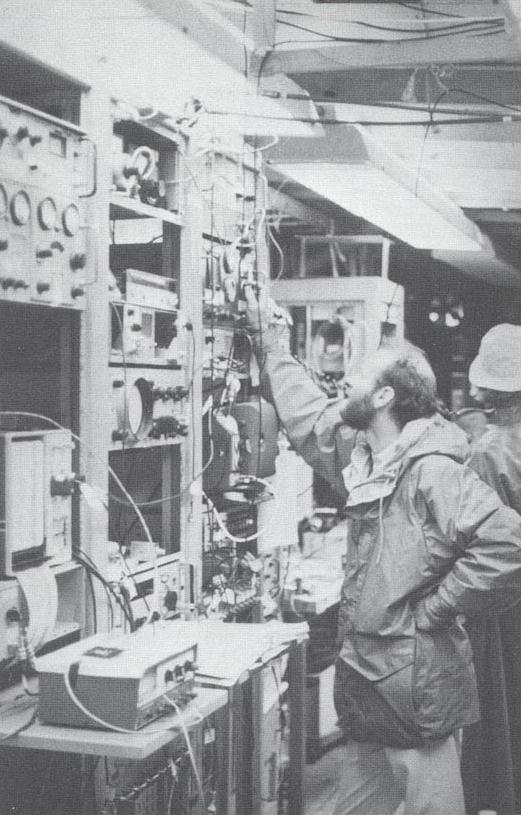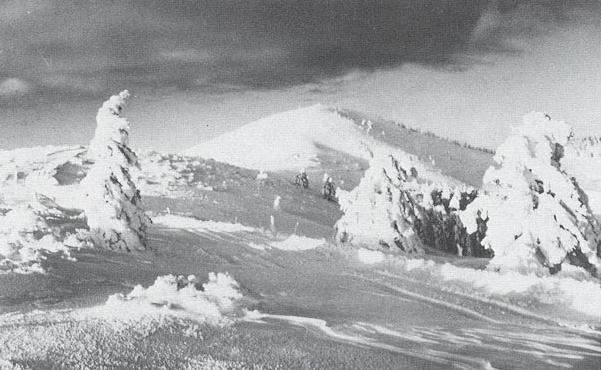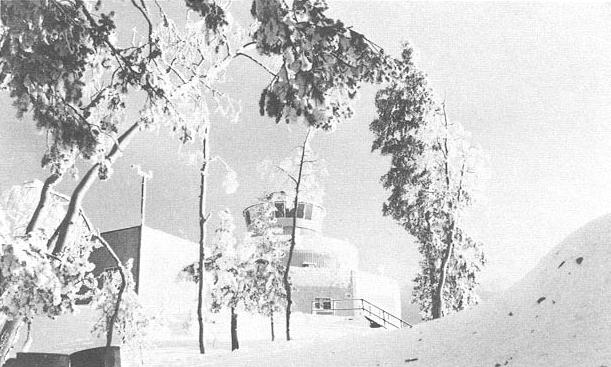9
Where Do They Go From Here?
Now that Langmuir Laboratory has been around for twenty-five years, it is natural to ask what the future holds in store. Of course, it's not possible to accurately predict the future of a course of investigation. But although the Langmuir researchers may not know exactly where they will end up, they do have a good idea of the direction they are going in.
First, they are going to keep looking for money. In 1935, E. J. Workman began his research efforts on a budget of about $350. Today, a single research project might cost in the neighborhood of $100,000 per year. A senior research physicist at a university laboratory draws an annual salary in the range of $30,000 to $40,000. The equipment in the scientist's lab is far more sophisticated than that of yesteryear--and far more expensive. The administrative overhead that Workman refused to pay to UNM is now accepted as a fact of university life. Even the physical necessities of running a remote laboratory--electricity, gasoline, food--cost much more than they did fifty or even twenty-five years ago. Today, more than ever before, scientific research is big business.
The primary support for Langmuir Laboratory has always come from the Office of Naval Research and the National Science Foundation in the form of grants both to the lab and to individual research projects. But the ONR, which is a branch of the Navy, and the NSF, which is the Federal government's principal scientific funding agency, are both subject to the budgetary whims of the president and the congress. The last few administrations have not been kind to basic research. Moore has his reservations about defense research, but both money and data are in store for the lab if weapons scientists come there. The NSF still provides a large part of the funding, but Langmuir scientists, like university researchers everywhere, are encouraged to find money wherever it is available.
But this need to search for money is taken for granted in the research world. When the scientists at Langmuir make plans, they think more in terms of unsolved problems in the field and the possible ways of investigating them.
In 1961, Marx Brook pointed out the usefulness of visual observation in an age of radars, remote sensors, and digital data-recording devices. His comments are as valid today as they were a quarter of a century ago. Fittingly, Brook is one of the leaders in using a new vantage point for observing lightning: the space shuttle.
Astronauts have always been interested in lightning, especially during countdown and launch, when it presents a hazard to their spacecraft and themselves. In orbit, far above the earth's atmosphere, they can take a more objective view. John Glenn, orbiting in his Mercury capsule, noticed lightning but did not pay much attention to it. Pete Conrad, returning from the moon aboard Apollo 12, reported seeing "lightning flashes ripping up the entire nighttime side of Earth." Edward Gibson, observing from Skylab, added a new twist. He reported that one bolt would seem to be followed by a great many more, almost as though there were some kind of collective organization to lightning strokes throughout a storm system.
For years, these remained isolated observations by non-specialists, the kind of anecdotal data that does not carry much weight. For all their lack of scientific rigor, though, the astronauts' reports are enormously exciting to atmospheric physicists. Before the shuttle, it was impossible to study the subject further, because the astronauts had many other duties. But space flight is now somewhat more routine, so scientists can follow this line of inquiry.
That came to pass in 1981 with the introduction of the space shuttle. Brook, Vonnegut, and NASA's Otha H. Vaughan, Jr., developed lightning-observation equipment and personally trained several shuttle crews in lightning observation techniques: where to look, what they could expect to see, and what information was needed to make their observations scientifically useful. The second, fourth, and sixth shuttle missions carried optical detectors to spot light-fling and sixteen-millimeter cameras with which to film it. Even these early efforts provided useful data. For example, lightning strokes were seen propagating horizontally at up to 320,000 feet per second and extending as far as fifty miles.
Complicating the picture, shuttle astronaut R. H. Truly reported that two thunderstorms above the Amazon appeared to be "talking to one another" in terms of simultaneous lightning. The scientists continue to entreat NASA to put lightning observations on the agenda for shuttle flights and to incorporate a lightning sensor in a geosynchronous satellite sometime in the late eighties. In the meantime, they wonder what might cause lightning flashes to be collectively organized, if indeed they are, and what old hypotheses this might support or disprove.
Now and then, NASA has also provided the Langmuir researchers with another observation platform, the U-2 reconnaissance plane. The U-2, designed for spy missions, is essentially a jet-propelled sailplane. At its cruising altitude of 70,000 feet, it can look down on an entire thundercloud, giving scientists a perspective in between the global panorama from orbit and the close-up view available from ordinary aircraft.
|
|
|
Bernard Vonnegut Charles Moore photograph. |
The question of cloud electrification, one of the fields Workman and Holzer probed in the mid-1930s, has yet to be conclusively answered. Moore, Vonnegut, and a few other atmospheric physicists believe that convective transfer of space charge plays the major role. Most of their colleagues disagree, but that does not stop communication on the subject; if anything, it helps the investigation by encouraging debate. The feelings run strong but not hard.
Of course, these scientists do enjoy their arguments. Back in the mid-fifties, Workman, Brook, and Reynolds would often gather in a downstairs lab beneath Workman's apartment in the Research Building for an evening of shoptalk. When the night grew short and the decibel level grew high, Workman's wife would bang on the floor with her cane. "You boys stop fighting," she would say. "It's time to go to bed."
Those days are long gone, and so are most of the people. Workman died in 1981 at his retirement home in Santa Barbara, California, having founded not one but two atmospheric research laboratories in his eighty-two years. Reynolds left both New Mexico Tech and atmospheric physics in 1955 to become the New Mexico State Engineer. But Brook is still there; he and Moore carry on a tradition as old as science itself, the tradition of hollering at each other over the divergent conclusions they have drawn from data available to both.
As the director of the Research and Development Division, Brook is Moore's boss as far as research is concerned. In an academic research setting, the term "boss" carries few of its industrial overtones, but more than once Brook could have probably driven Moore away from the school. It certainly would not have been the first time a senior professor had done such a thing. But Brook has chosen not to do so. High priest and heretic, both full professors, have their offices almost within shouting distance of each other in Workman Center, and their differing ideas coexist in the Journal of Geophysical Research.
Perhaps one hypothesis or the other will win out; perhaps one man or both will live to see that day. It is also possible that some new hypothesis will displace both. Only time and experimentation will tell. The way in which these scientists work is very human, affected by emotion, politics, finance, and a thousand other seemingly unscientific factors. But the work itself is physics, and the ultimate test of a hypothesis is how well it explains some aspect of the physical world.
Toward that end, the charge-carrying cable across Sawmill Canyon, blown down in an ice storm in 1981, was put back up in 1984. Attempts to invert the polarity of clouds by releasing negative charge into their bases were apparently successful in 1984 and 1985, providing highly suggestive, partial evidence. Moore and Vonnegut are doing further work with the cable, trying to obtain proof, or at least the closest thing to proof that one gets in atmospheric physics.
While the atmospheric electricians, as they call themselves, wrangle over lightning and charge separation, others at Langmuir are studying the physical dynamics of the thundercloud. The National Center for Atmospheric Research and the National Oceanic and Atmospheric Administration provided four sophisticated Doppler radars in 1984. One radar was hauled up to the mountaintop. The other three were placed in a rough triangle on the surrounding plains.
The Doppler radars make use of the Doppler effect: the fact that the length of any wave, electromagnetic or mechanical, becomes longer or shorter depending on whether the source is going away from or toward the observer. This principle explains the rise and fall of the whistle of a passing train. The Doppler effect is used in various forms by a great many people. Astronomers measure the Doppler shift, or "red shift," of light from stars and galaxies to determine the motion of those heavenly bodies relative to the earth. State troopers use Doppler radar to measure the red shifts of receding sports cars.
In Doppler radar, the reflected beam is longer in wavelength that the transmitted beam if the target is receding. Similarly, it is shorter in wavelength if the target is approaching. By measuring the amount of change, atmospheric scientists can tell approximately what the winds in the different parts of a cloud are like. Doppler radars for atmospheric physics, equipped with high-speed data-recording equipment, cost upwards of a million dollars apiece. Langmuir Lab gets them now and then by inviting their federally funded owners to spend the summer at the lab.
|
|
|
Bill Winn in balloon hangar, 1977. |
The flow of air outside the actual storm is also important in these studies, but radars cannot "see" clear air no matter how fast it is moving. Aircraft, often including a Sabreliner business jet from the National Center for Atmospheric Research, are flown around the storms to measure these winds directly. The Sabreliner has also been used to drop radar-reflecting chaff into the clear air around the storms.
While most of the studies at Langmuir and the related research at New Mexico Tech have been pure science, directed toward a better understanding of thunderstorms, the work has some practical applications. In the early eighties, Brook helped develop a new kind of electrostatic precipitator to clean the fly ash out of smokestack emissions. By using an electrified aerosol of water droplets--in other words, applied cloud physics--this precipitator can scrub out tiny particles that conventional precipitators miss.
Although the new smokestack scrubber is applied science and has little to do with improving our understanding of clouds, it nonetheless reflects the essence of the way these physicists work. Mathematical ability is necessary to their work, of course, and so is a good understanding of instrumentation. But what really distinguishes them is the ability to gather all kinds of knowledge and skills and bring it all to bear on one narrow, specialized problem. No law says that the narrow problem has to be in one's own subspecialty; in fact, over a thirty-year career, a physicist is quite likely to probe several areas. Brook's venture into pollution control is no more unusual than Moore's teaching of a machine-shop course or Holmes's early work in geophysics.
There are other practical applications, both obvious and hidden, of the work being done at Langmuir. Studies of lightning and its physical and electromagnetic effects will undoubtedly continue to be one of the lab's main concerns. With two kivas built and running, the ground under the chicken wire on top of Baldy is becoming crowded. But two kivas bring in data that amounts to an embarassment of riches; as with many aspects of modern science, the problem is not to get the raw facts, but to get the time and personnel to put it all together and make sense out of it.
As the Irving Langmuir Laboratory for Atmospheric Research begins its second quarter-century, the various fields of inquiry related to thunderstorms will receive more and more attention. Many things have changed over the years. Old researchers have retired and new ones have begun working their way up. The facilities have been greatly expanded. Tube-type equipment that belongs in a museum is being replaced with ultramodern, solid-state, computerized apparatus that often does a better job. The scientists have made some important discoveries and have also added to the great ash heaps of negative data that result from most scientific research. But for all the changes, the primary goal remains the same: to apply the capabilities of modern instrumentation and the rigor of mathematical analysis to the study of one of the oldest enigmas on the planet, the thunderstorm.
|
|
|
|
|
Winter on south Baldy. |
Winter at Langmuir. |
|
|
Marvin Wilkening photos. |
||
Next: Appendix I
Previous: Chapter 8 -- Lightning Hazards




